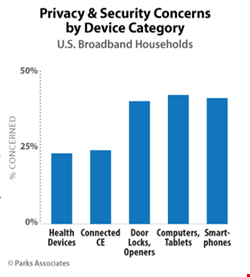Connected home. Connected car. Connected kettle. Yada yada yada. What more can you say about the connected home environment? Well when it comes to security, quite a bit really.
Even though there is nothing new about the wiring up of appliances, the whole internet of things (IoT) market is on a surge right now as the demarcation lines between the home and the office blur into non-existence.
But as smart home experiences get richer, encompassing energy management, interactive home devices, connected appliances and real-time entry protection solutions, among others, home owners are increasingly opening up their cyber front doors (and those of the office) to potential vulnerabilities.
It’s something that recent research by Frost & Sullivan and the Continental Automated Buildings Association (CABA) has revealed rather clearly. The analysis set out to create an understanding of the magnitude of cyber-threats and how they can be managed and eliminated in addition to the challenges of adopting and implementing cybersecurity measures.
“Although meant to enable connected experiences, allowing third parties open access to home networks exposes both the consumer as well as the service providers to the potential vulnerabilities of cyberspace. It is critical to understand that cyber threats require collective responsibility and accountability sharing from all stakeholders involved,” noted Frost & Sullivan Principal Consultant for Energy & Environment Konkana Khaund. “Cyber-threats to the connected home are indeed being taken seriously by such participants.”
Moreover, these threats have the potential to derail smart home growth.
Further research into the topic by Parks Associates concurred with the F&S/CABA study’s general thrust that IoT is a land of plenty offering consumers convenience, efficiency, collaboration and expanded products and services. Worryingly, though, it added that concerns about privacy and data security posed major challenges to the industry; identity theft, invasive data mining, cyber-terrorism, and physical dangers from hacked devices were scaring consumers. It urged the industry that it had a duty to safeguard consumers and the data that is an extension of them.

In the survey, approximately half of broadband households expressed privacy or security concerns about smart home devices. Identity theft or data theft by hackers was the first or second leading privacy concern in eight of nine product categories surveyed. “Essentially, with big data comes big responsibility,” Parks warned.
On a brighter note, Parks also revealed that a combination of privacy rights can relieve up to 74% of privacy concerns. (Apart from those worrying about their Ashley Madison account?)
The IoT genie is definitively out of the bottle yet who knows what devices of what security status are being applied to the same home networks on which corporate information is flowing. Parks is right in its conclusion that ultimately the success of the IoT will be influenced significantly by the degree to which security concerns are addressed vis à vis other priorities, and by how well vulnerabilities are mediated by new security technologies, standards, and best practices.
Looking at these latter three items, the security industry can easily offer solid technology that is compliant to rigorous standards. But best practices? Now that is going to be a big ask, if not a potential big (smart) headache.
